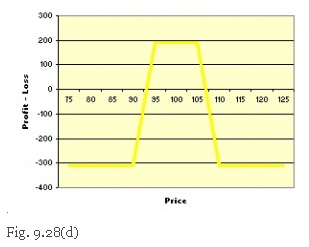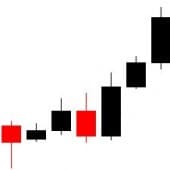Anyone who goes on an introductory course in options trading will no doubt become familiar with credit spreads. This remains one of the most popular trading strategies among traders of all levels for a variety of reasons.
Definition
A credit spread is an options trading spread for which the trader does not have to pay an upfront fee. Instead the trader is actually paid to set up a credit spread! The reason for this is that credit spreads involve selling more expensive options and buying cheaper ones, which means the net premium results in a credit to the trader’s account.
Margin and trading Level
There is a trade-off though: whereas a debit spread does not involve any margin, since the trade can usually not lose more than the net cost to set up the position, a credit spread sometimes has the potential to lose an unlimited amount of money. This results in broker requiring a margin deposit before a trader can set up a debit spread. For stock options a higher trading level is usually also required than for debit spreads.
Benefits of credit spreads
Whereas most debit spreads require the price of the underlying asset to move either up or down in order to profit, credit spreads have the unique ability to profit if the price of the underlying asset remains stagnant or moves in a narrow range.
Although some credit spreads have unlimited potential for loss, there are also many other credit spreads with a limited potential for loss.
While credit spreads require a margin deposit, they still require a smaller margin deposit than naked puts or naked calls. In fact the lower margin involved is one of the reasons why many traders prefer credit spreads over selling naked options.
Although most credit spreads will profit in a stagnant or range-trading market, there are also credit spreads that will profit if the market breaks out either to the upside or the downside.
Examples:
A credit spread for bullish markets
Below is an example of a typical bullish credit spread, the bull put spread. This involves selling ATM put options and simultaneously buying OTM put options for the same expiration date.
A credit spread for bearish markets
Below is an example of a credit spread for a bearish market. The bear call is set up by selling ATM call options and simultaneously buying the same number of OTM call options for the same expiration date.
A credit spread for neutral markets
If a trader believes the market will remain either stagnant or range-bound until the expiration date he or she can’t do much better than a credit spread specifically intended for neutral markets. One such example is the very popular iron condor, which consists of selling OTM calls and OTM puts while simultaneously buying further OTM calls and puts which are cheaper.
Fig. 9.28(d) is an example of a typical iron condor credit spread.
A credit spread for volatile markets
If it is highly likely that the price of the underlying asset will break out either to the upside or the downside, a trader should opt for a credit spread designed specifically to benefit from this situation. An example in this regard is the ever popular short butterfly spread that is illustrated below in Fig. 9.28(e).
This trade is set up by buying two ATM call options and simultaneously selling an OTM call and an ITM call. The higher premium income from the ITM call helps to more than offset the cost of the ATM calls, creating a net credit.
Conclusion
While credit spreads can be ideal under certain circumstances, one always has to take into account a) the probability of the trade actually realising a profit and b) whether the maximum risk/maximum profit payoff justifies the trade.
- English (UK)
- English (India)
- English (Canada)
- English (Australia)
- English (South Africa)
- English (Philippines)
- English (Nigeria)
- Deutsch
- Español (España)
- Español (México)
- Français
- Italiano
- Nederlands
- Português (Portugal)
- Polski
- Português (Brasil)
- Русский
- Türkçe
- العربية
- Ελληνικά
- Svenska
- Suomi
- עברית
- 日本語
- 한국어
- 简体中文
- 繁體中文
- Bahasa Indonesia
- Bahasa Melayu
- ไทย
- Tiếng Việt
- हिंदी
Credit Spreads: Explained
Published 01/22/2013, 01:54 AM
Updated 07/09/2023, 06:31 AM
Credit Spreads: Explained
Latest comments
Loading next article…
Install Our App
Risk Disclosure: Trading in financial instruments and/or cryptocurrencies involves high risks including the risk of losing some, or all, of your investment amount, and may not be suitable for all investors. Prices of cryptocurrencies are extremely volatile and may be affected by external factors such as financial, regulatory or political events. Trading on margin increases the financial risks.
Before deciding to trade in financial instrument or cryptocurrencies you should be fully informed of the risks and costs associated with trading the financial markets, carefully consider your investment objectives, level of experience, and risk appetite, and seek professional advice where needed.
Fusion Media would like to remind you that the data contained in this website is not necessarily real-time nor accurate. The data and prices on the website are not necessarily provided by any market or exchange, but may be provided by market makers, and so prices may not be accurate and may differ from the actual price at any given market, meaning prices are indicative and not appropriate for trading purposes. Fusion Media and any provider of the data contained in this website will not accept liability for any loss or damage as a result of your trading, or your reliance on the information contained within this website.
It is prohibited to use, store, reproduce, display, modify, transmit or distribute the data contained in this website without the explicit prior written permission of Fusion Media and/or the data provider. All intellectual property rights are reserved by the providers and/or the exchange providing the data contained in this website.
Fusion Media may be compensated by the advertisers that appear on the website, based on your interaction with the advertisements or advertisers.
Before deciding to trade in financial instrument or cryptocurrencies you should be fully informed of the risks and costs associated with trading the financial markets, carefully consider your investment objectives, level of experience, and risk appetite, and seek professional advice where needed.
Fusion Media would like to remind you that the data contained in this website is not necessarily real-time nor accurate. The data and prices on the website are not necessarily provided by any market or exchange, but may be provided by market makers, and so prices may not be accurate and may differ from the actual price at any given market, meaning prices are indicative and not appropriate for trading purposes. Fusion Media and any provider of the data contained in this website will not accept liability for any loss or damage as a result of your trading, or your reliance on the information contained within this website.
It is prohibited to use, store, reproduce, display, modify, transmit or distribute the data contained in this website without the explicit prior written permission of Fusion Media and/or the data provider. All intellectual property rights are reserved by the providers and/or the exchange providing the data contained in this website.
Fusion Media may be compensated by the advertisers that appear on the website, based on your interaction with the advertisements or advertisers.
© 2007-2024 - Fusion Media Limited. All Rights Reserved.
